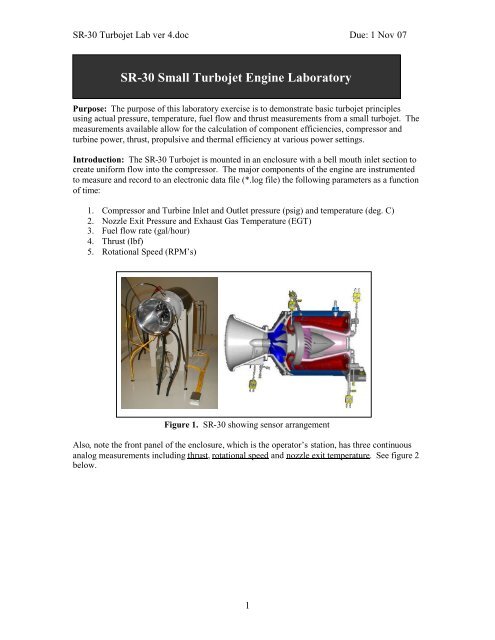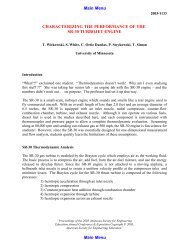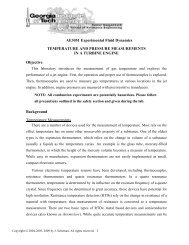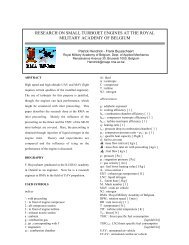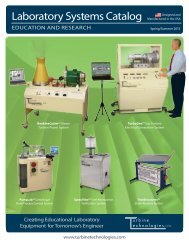SR-30 Small Turbojet Engine Laboratory - Turbine Technologies
SR-30 Small Turbojet Engine Laboratory - Turbine Technologies
SR-30 Small Turbojet Engine Laboratory - Turbine Technologies
You also want an ePaper? Increase the reach of your titles
YUMPU automatically turns print PDFs into web optimized ePapers that Google loves.
<strong>SR</strong>-<strong>30</strong> <strong>Turbojet</strong> Lab ver 4.doc Due: 1 Nov 07<br />
<strong>SR</strong>-<strong>30</strong> <strong>Small</strong> <strong>Turbojet</strong> <strong>Engine</strong> <strong>Laboratory</strong><br />
Purpose: The purpose of this laboratory exercise is to demonstrate basic turbojet principles<br />
using actual pressure, temperature, fuel flow and thrust measurements from a small turbojet. The<br />
measurements available allow for the calculation of component efficiencies, compressor and<br />
turbine power, thrust, propulsive and thermal efficiency at various power settings.<br />
Introduction: The <strong>SR</strong>-<strong>30</strong> <strong>Turbojet</strong> is mounted in an enclosure with a bell mouth inlet section to<br />
create uniform flow into the compressor. The major components of the engine are instrumented<br />
to measure and record to an electronic data file (*.log file) the following parameters as a function<br />
of time:<br />
1. Compressor and <strong>Turbine</strong> Inlet and Outlet pressure (psig) and temperature (deg. C)<br />
2. Nozzle Exit Pressure and Exhaust Gas Temperature (EGT)<br />
3. Fuel flow rate (gal/hour)<br />
4. Thrust (lbf)<br />
5. Rotational Speed (RPM’s)<br />
Figure 1. <strong>SR</strong>-<strong>30</strong> showing sensor arrangement<br />
Also, note the front panel of the enclosure, which is the operator’s station, has three continuous<br />
analog measurements including thrust, rotational speed and nozzle exit temperature. See figure 2<br />
below.<br />
1
<strong>SR</strong>-<strong>30</strong> <strong>Turbojet</strong> Lab ver 4.doc Due: 1 Nov 07<br />
Figure 2. <strong>SR</strong>-<strong>30</strong> front panel and data acquisition system<br />
The data acquisition system is provided using a PC and software allowing continuous display of<br />
measurements from the <strong>SR</strong>-<strong>30</strong> as well as a data logging feature, placing parameters in a flat file<br />
such as “filename.log”. This file is easily imported to Microsoft Excel or Matlab for later<br />
analysis of the data. The data-acquisition software operation is relatively simple and will be<br />
reviewed at the beginning of the lab.<br />
Safety: During operations of the <strong>SR</strong>-<strong>30</strong> all personnel are required to wear hearing protection and<br />
skylarking is strictly forbidden. The faculty and <strong>SR</strong>-<strong>30</strong> operator will provide further system<br />
safety guidance as required. Some other safety issues are enumerated below from<br />
http://kahuna.sdsu.edu/~bjones<br />
WARNING<br />
Make sure that neither you nor any of your belongings are placed in front of the intake or<br />
the exhaust sections of the <strong>SR</strong>-<strong>30</strong> engine while it is operating.<br />
Ear protection must be worn while the <strong>SR</strong>-<strong>30</strong> engine is operating.<br />
The <strong>SR</strong>-<strong>30</strong> engine rotates at very high speeds. Stay as far from the test bench as practical<br />
to avoid injury if the engine malfunctions.<br />
<br />
Make sure the engine low-oil-pressure light extinguishes immediately after engine startup.<br />
If the light stays illuminated or lights at any time during engine operation turn off the<br />
fuel flow to the <strong>SR</strong>-<strong>30</strong> engine immediately.<br />
Observe the vibration sensor indicator on the far right side of the control panel. If the<br />
indicator voltage increases at any time during engine operation turn off the fuel flow to<br />
the <strong>SR</strong>-<strong>30</strong> engine immediately.<br />
If at any time you suspect the <strong>SR</strong>-<strong>30</strong> engine is not operating properly immediately turn off<br />
the fuel flow and shut down the engine.<br />
Upon engine start, if the engine starts but does not increase to idle speed (40,000 rpm)<br />
turn the air start back on until the engine reaches <strong>30</strong>,000 rpm. Then turn the air-start off.<br />
2
<strong>SR</strong>-<strong>30</strong> <strong>Turbojet</strong> Lab ver 4.doc Due: 1 Nov 07<br />
Procedure: The sequence of events for the <strong>SR</strong>-<strong>30</strong> laboratory are as follows:<br />
1. Prior to start-up of the engine students will review the data acquisition software<br />
operations, obtain hearing protection and record start of lab ambient conditions. The data<br />
acquisition mode should be “fast” and data-logging should be “on”. Also any physical<br />
measurements should be made at this time – atmospheric conditions, nozzle/inlet<br />
geometry.<br />
2. The operator will start the <strong>SR</strong>-<strong>30</strong> and allow it to remain at idle RPM (about 48,000) while<br />
the components warm up to a steady state conditions (about 5 minutes). Students should<br />
record the analog readings from the operators console after the system reaches steady<br />
state. Trends can be observed by watching the traces in the data acquisition software<br />
window.<br />
Figure 3. Sample data acquisition screen showing data traces/trends<br />
3. This procedure will be repeated for 60,000, 70,000 and 80,000 RPM as well as full<br />
throttle (about 86,600 RPM) allowing time for temperatures to come to a quasi-steady<br />
state value. The engine will then be returned to an idle throttle setting for one final set of<br />
readings and shut down.<br />
4. The *.log file must be extracted onto disk or flash memory for later use.<br />
All figures obtained from: http://bookitec.co.kr/avionics.htm<br />
Purpose: The purpose of this laboratory is to examine the performance of <strong>SR</strong>-<strong>30</strong> <strong>Turbojet</strong>.<br />
From this exercise, you should be able to evaluate important component parameters that<br />
contribute to the performance of the turbojet system. This exercise will combine analysis of <strong>SR</strong>-<br />
<strong>30</strong> data with the use of GASTURB10.<br />
Results: Work on this laboratory in groups of two (2) to complete the calculations listed below.<br />
Sample calculations should be provided for at least one power setting, which will serve to<br />
indicate your calculation procedure and assumptions. Do the calculations by hand and summarize<br />
in tables and plots I can read!<br />
1. Estimate of turbine inlet temperature if required. Describe the process used to make this<br />
estimate. You should assume variable gas properties for all calculations (c p , and R gas )<br />
3
<strong>SR</strong>-<strong>30</strong> <strong>Turbojet</strong> Lab ver 4.doc Due: 1 Nov 07<br />
2. Compressor and turbine work rate (hp and kW) and estimate of mechanical efficiency<br />
3. Compressor and turbine efficiencies<br />
4. Estimate engine mass flow rate (lb/sec, kg/sec)<br />
5. Estimate engine exit velocity (ft/sec, m/sec) – what is the inlet velocity Can you<br />
estimate it<br />
6. Describe the state of the nozzle; converging only, choked, not choked. What is the exit<br />
Mach number Please make sure you get the proper dimensions for the nozzle and inlet.<br />
7. Estimate thrust using the thermodynamic data and relationships from Chapter 5 of our<br />
class handout and compare to measured values (lbf, N)<br />
8. Determine TSFC (lbm/lbf-hr, kg/N-hr)<br />
9. <strong>SR</strong>-<strong>30</strong> thermal efficiency. What is the propulsive efficiency Can it be determined<br />
Discussion questions: Answer the following discussion questions to form the basis for your<br />
discussion and conclusions.<br />
1. In order to complete the above calculations you had to make some assumptions. Please<br />
comment on these and any other workarounds required to determine engine parameters.<br />
2. The <strong>SR</strong>-<strong>30</strong> operated at various power settings during this lab. Did <strong>SR</strong>-<strong>30</strong> operate at the<br />
maximum power or efficiency condition(s) during this lab (look at pressure ratio) or<br />
something else What is the maximum thrust pressure ratio ( c *) and what would the<br />
net thrust, TSFC and thermal efficiency of <strong>SR</strong>-<strong>30</strong> be at maximum thrust pressure ratio<br />
3. Plot experimental values of c , thrust and thermal efficiency versus RPM Describe the<br />
relationship between these three and RPM.<br />
4. How would you characterize the <strong>SR</strong>-<strong>30</strong> in terms of performance How would you<br />
describe this engine to someone who was looking at it for a real application<br />
Now using GASTURB10 do the following:<br />
5. Plot specific thrust, TSFC and core efficiency as function of c using the T max /T min ratio<br />
for 80,000 RPMs. Do this for three flight Mach numbers on a single plot and then<br />
another Thrust/TSFC versus c plot with three different altitudes. Make selections that<br />
indicate the variation with Mach number and altitude.<br />
6. Create a turbojet map for the <strong>SR</strong>-<strong>30</strong> by plotting TSFC (lb/lbf-hr) versus Specific Thrust<br />
(lbf-sec/lb) between pressure ratios of 2-3 and turbine inlet temperatures of 900K to<br />
1050K. This will be a contour map of c and T t4 . Adjust values to create a meaningful<br />
map.<br />
Deliverables: Perform all the tasks above in a very professional manner. Please note this is not a<br />
formal laboratory write-up, but an informal format might be a good compromise. I do not need a<br />
description of the set-up or any long-winded description of the importance of turbojets to the<br />
Navy or the universe at large. Just a description of what you did, how you did it and a clear<br />
demonstration that you understand turbojet calculations!<br />
4


